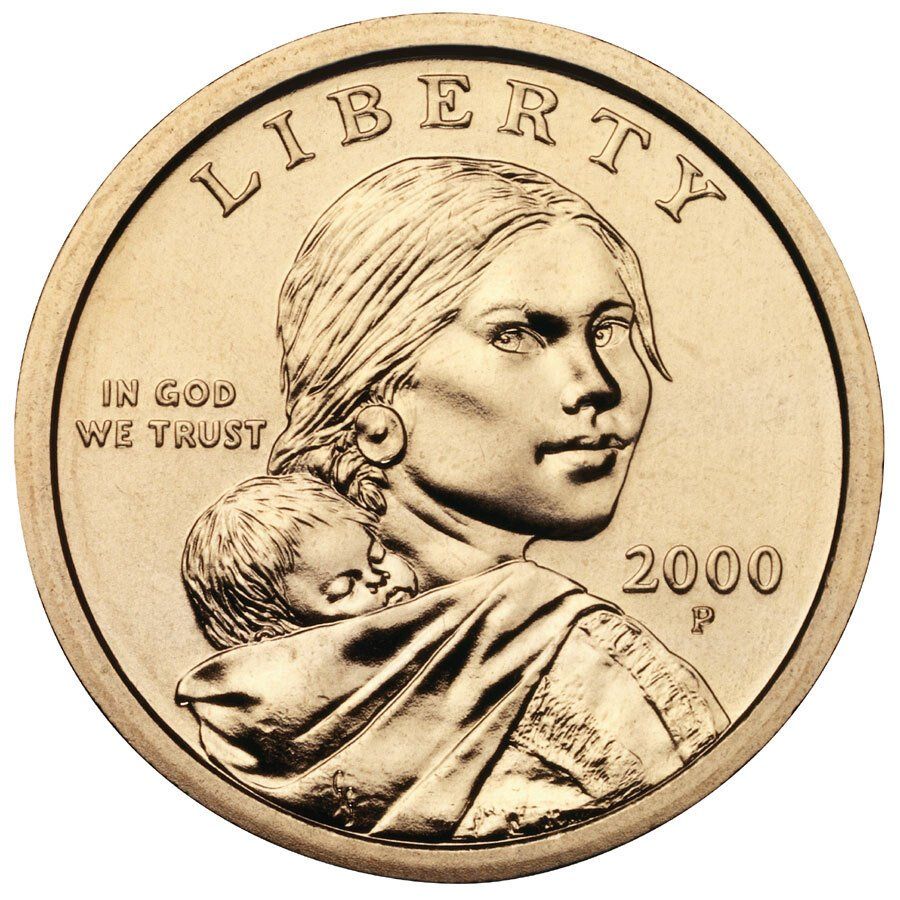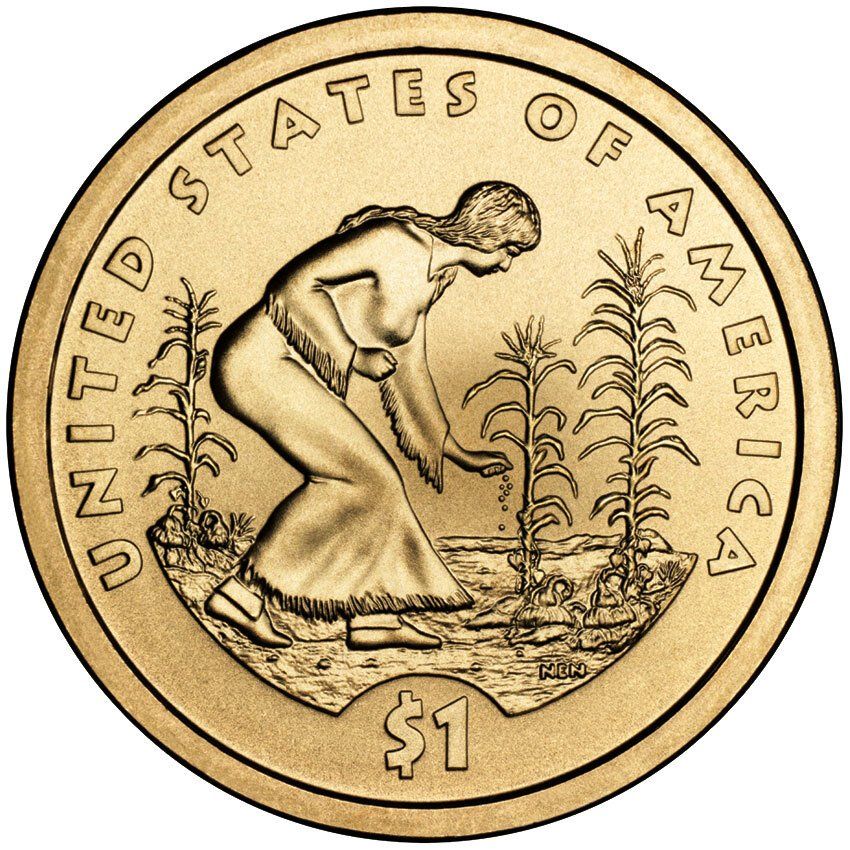The history of the Sacagawea dollar
The Golden Dollar
The Sacagawea coin, which is also known as the “golden dollar” was first introduced in the year 2000. It wasn’t very popular with the general public and due to that it was not minted for general circulation for a few years between 2002-2008, and then again from 2012-present.
However quite a bit went into the making of this coin, and whether you’re one who likes it or not, it’s always nice to know the story behind a coin right?
The United States $1 Coin Act of 1997
In 1997, it was time for a new dollar coin. The
Susan B. Anthony coin stock had finally been depleted and legislation was introduced that the new dollar to be struck “shall be golden in color, have a distinctive edge” and “have tactile and visual features that make the denomination of the coin readily discernible”.
This was to make it clearly distinguishable from the quarter, which is similar in size.
But during this time, there was still a demand for dollar coins and none to fill it. It would take several years for the new coin to be produced, so the Act also gave authority to the Secretary of the Treasury to produce Susan B. Anthony dollars yet again for one year. This helped meet the demand for dollar coins while the Sacagawea coin was being produced.
The Act that was introduced did not say what was to appear on the coin, so Secretary of the Treasury, Robert Rubin, appointed a nine-member Dollar Coin Design Advisory Committee. The rules were that the coin had to feature a representation of at least one woman, and it couldn’t depict a living person.
There were many suggestions, ideas, and concepts submitted to the committee by the public, and they contemplated all of them. And June 9, 1998, the committee recommended Sacagawea, the Shoshone guide of the Lewis and Clark Expedition.
Competition for the Dollar Coin Design
With the subject decided on, a competition was held. 23 artists were invited to submit their designs for the new dollar coin. The guideline for the contest included what the depictions must be--Sacagawea on the obverse, and an eagle on the reverse--as well as to “be sensitive to cultural authenticity, and try to avoid creating a representation of a classical European face in Native American Headdress”.
Don’t want a repeat of the Indian Head Cent! Or the Indian Head Gold Eagle for that matter.
The designs were reviewed in December, 1998, by members of the Native American community, teachers, numismatists, historians, members of Congress, as well as various government officials. There were a number of “rounds” of choosing the coins, in the first round, six obverse and seven reverse designs were chosen.
The Mint then held some polls and focus groups, and in the next “round” three obverse and four reverse designs were selected. Apparently, the Mint received nearly 90,000 emails in reference to the design selection process.
Now remember, this is 1998. Yeah we had the internet, but it was still new! This was unheard of in the sense of receiving feedback on Mint designs. They had never been able to reach so many people before.
The Final Design for the Sacagawea Dollar Coin
The final seven designs that were chosen then went on to the United States Commission of Fine Arts, where the Commission chose the obverse design that depicted Sacagawea with her infant son, this was designed by Glenna Goodacre. The model Goodacre chose for the design was
Randy’L He-dow Teton, a Shoshone-Bannock/Cree from Southeastern Idaho.
After modeling for the new dollar coin, Teton toured the country as a motivational speaker to encourage Native American education as well as promote the new coin. Teton stated that “the image doesn’t represent me, it represents all Native American women. All women have the dignity of the Golden Dollar’s image.”
The reverse that was chosen depicted a soaring eagle surrounded by stars, and was designed by Thomas D. Rogers, a sculptor-engraver at the United States Mint.
Marketing the New Dollar Coin
In preparation for the release of the new Sacagawea dollar coin, the Mint partnered with Walmart and Sam’s Club, and even General Mills!
They sent $100 million dollars worth of dollar coins to the stores to be distributed.
Their partnership with General Mills was a
bit more interesting. 10,000,000 boxes of cheerios were to have a 2000 Lincoln cent as a prize, but one in every 2,000 boxes would have a new Sacagawea dollar instead.
But there was more to it!
Every 4,400 would have a certificate redeemable for 100 Sacagawea dollar coins!
It turned out later that those one dollar coins in every 2,000 of the boxes were actually early strikes of the Sacagawea dollar! These differed from the strikes that were released for general circulation
and can be very valuable!
There’s an estimated 5,500 of these coins! Definitely a valuable coin to look out for. They can be
identified by the tail feathers on the reverse, as they have much more defined lines than the regular circulation strikes.
Sending the Sacagawea Dollar into Space
In 1999, twelve Sacagawea dollar coins were struck in .9167 fine (22-karat) gold. These were struck to “commemorate the historic flight of the space shuttle Columbia in July 1999”. They were sent aboard the shuttle, and after returning to earth they were stored in Fort Knox. They stayed in Fort Knox until 2007, when they were
shown at the ANA’s World’s Fair of Money. They were returned to Fort Knox after the exhibition, and is where they remain to this day.
Public Reception of the Sacagawea Coin
Reception of the new dollar coin had mixed reviews, with one senator referring to it as looking like “play money”, while others applauded the design. However it proved to be rather unpopular in everyday use and the mintage dropped by a whopping 90% the following year.
From 2002-2008, the coin did not get minted for general circulation and was instead only produced for collectors in small mintages.
Re-Introduction of the Native American Dollar Coin
In 2009, the dollar coin was reintroduced to circulation with a new reverse design, this reverse design was mandated to change every year. These new coins were called Native American Dollars, and unfortunately were just as unpopular as the Sacagawea coin.
After yet another flop trying to get the dollar coin into commerce, Treasury Secretary Timothy F. Geithner announced that “all future dollar coin production would be for numismatic purposes only”.
There have been 13 different
reverse designs since the change, the new coins, mandated by the Native American $1 Coin Act (Signed by George W. Bush), must depict "images celebrating the important contributions made by Indian tribes and individual Native Americans to the development of the United States and the history of the United States."
All Rights Reserved | CoinCollecting.com




